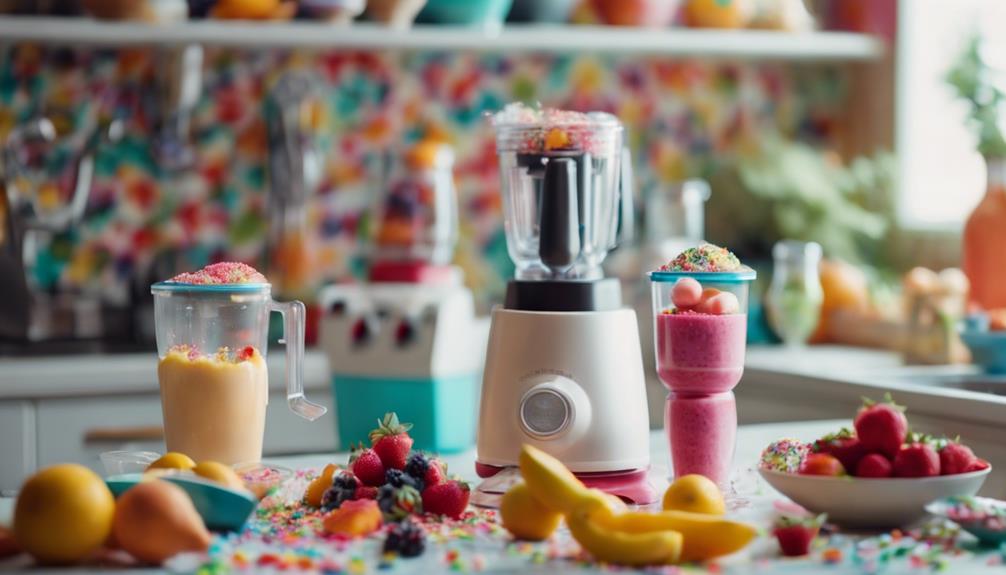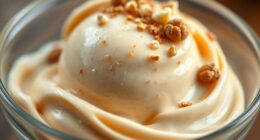Make the richest Ninja Creami vanilla ice cream by using high-quality ingredients and precise measurements. Ensure a professional finish by balancing the cream and milk, chilling the base before adding vanilla extract. Let the automated swirling process create a silky smooth texture. Add extra flair by customizing with mix-ins like chocolate chips or nuts. Proper storage and serving techniques will maintain freshness and creaminess. Experiment with freezing the base and adjusting churning times to achieve your preferred consistency. Explore additional tips and different ice cream makers for various textures. Perfect your ice cream texture every time!
Key Takeaways
- Follow precise measurements for cream, milk, and sugar.
- Chill base before adding vanilla extract for ideal consistency.
- Utilize Ninja Creami's 'Ice Cream' function for perfect texture.
- Experiment with mix-ins for enhanced taste and texture.
- Store ice cream properly to maintain creamy texture.
Essentials for Ninja Creami Vanilla Ice Cream
For crafting Ninja Creami vanilla ice cream, you must gather fresh cream, whole milk, granulated sugar, salt, and pure vanilla extract as essential ingredients. These quality ingredients are the foundation for a decadent flavor and creamy texture in your homemade ice cream.
The Ninja Creami vanilla ice cream recipe emphasizes the importance of precise measurements to achieve the perfect balance of flavors.
During the churning process, these ingredients come together to create a silky smooth texture that's characteristic of Ninja Creami ice cream. The meticulous balance of cream and milk ensures that the ice cream base churns into a luxurious treat with a professional touch.
Crafting the Creami Base
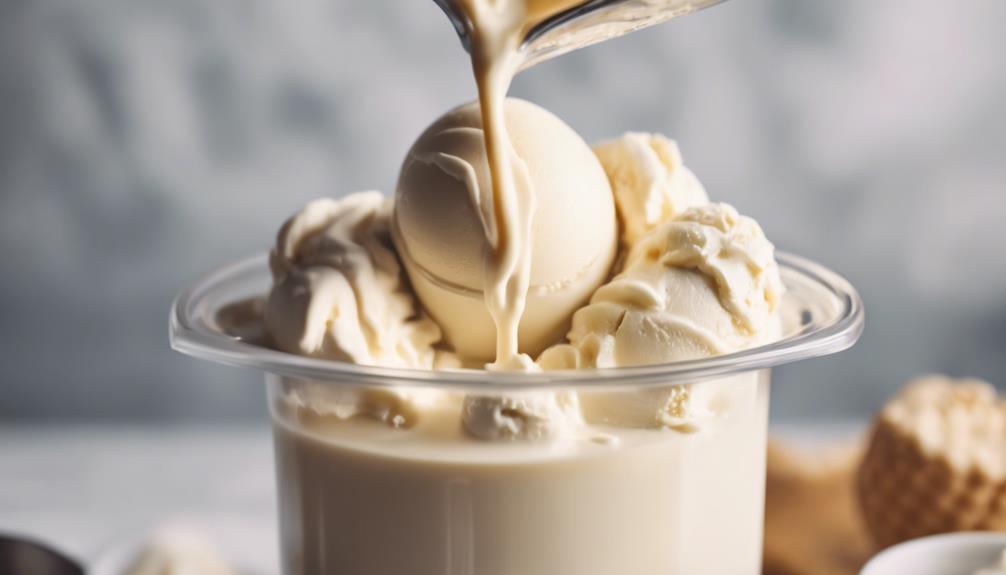
You must focus on the Creami base essentials to achieve the best texture in your vanilla ice cream.
Using quality ingredients and precise measurements is essential for a silky and rich flavor profile.
Follow the recipe steps carefully to guarantee a smooth and creamy outcome every time you use your Ninja Creami.
Creami Base Essentials
Craft a velvety Creami base for your Ninja Creami vanilla ice cream by combining fresh cream, whole milk, granulated sugar, salt, and pure vanilla extract with precision and care. Ensuring the right balance of these Creami base essentials is key to achieving a creamy texture and rich vanilla taste in your homemade ice cream. Here's a breakdown of the essential ingredients:
| Ingredient | Importance | Tip |
|---|---|---|
| Fresh Cream | Adds creaminess | Use high-quality cream |
| Whole Milk | Enhances texture | Opt for full-fat milk |
| Granulated Sugar | Sweetens and smooths | Dissolve completely |
| Salt | Balances flavors | Use a pinch |
| Vanilla Extract | Infuses with vanilla aroma | Add after cooling |
These essentials, when combined correctly, lay the foundation for a delectable Ninja Creami vanilla ice cream. Make sure to follow the steps precisely to create a base that guarantees a perfect scoop every time.
Achieving Optimal Texture
When crafting the Creami base for your Ninja Creami vanilla ice cream, make certain that the sugar is dissolved completely to avoid a grainy texture. Heat the mixture gently in the Ninja Creami machine to achieve a rich and creamy consistency. Proper proportions of cream, milk, sugar, and vanilla are essential for the perfect texture. Cooling the base before adding vanilla extract helps maintain ideal consistency after the first Ice Cream function cycle.
For a velvety texture, make sure you follow precise measurements and instructions when incorporating cream cheese into the mixture. The Ninja Creami machine works best when all ingredients are mixed thoroughly to avoid any lumps or inconsistencies in texture.
Churning Magic With Ninja Creami

Harness the swirling magic of the Ninja Creami to effortlessly transform frozen mixtures into velvety smooth ice cream.
The Ninja Creami's automated swirling process guarantees that your ice cream turns out with a perfect texture every time. By selecting the 'Ice Cream' function, you set the stage for consistent and professional results with just a touch of a button.
The swirling action not only eliminates unwanted ice crystals but also allows for fine-tuning the texture of your ice cream. If you encounter density issues or desire a creamier consistency, additional swirling can come to the rescue.
This feature enables you to adjust the texture during the swirling process, paving the way for a luxurious and satisfying end product.
Embrace the Ninja Creami's swirling capabilities to achieve your desired ice cream texture effortlessly and enjoy a delightful treat that meets your expectations.
Achieving Perfect Consistency
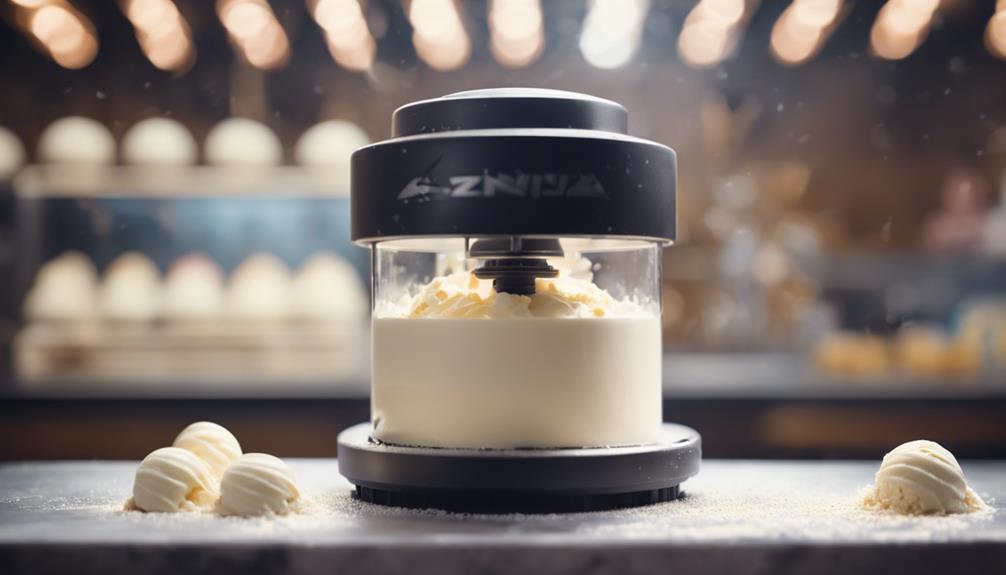
For a velvety smooth ice cream texture, ensuring proper churning of the ice cream base is essential. When using the Ninja Creami, achieving perfect consistency is within reach by following a few key steps.
Before churning, make sure the ice cream mixture is adequately frozen. This step is pivotal as it sets the foundation for the texture you desire.
Adjusting the churning time can also make a significant difference. Longer churning times can help eliminate any unwanted ice crystals, resulting in a smoother overall texture.
Throughout the churning process, pay close attention to the consistency of the mixture. Fine-tuning as you go allows you to tailor the texture to perfection.
Customizing Vanilla Creation

When customizing your vanilla ice cream, consider the mix-in options available to enhance flavor and texture. Experiment with different combinations to adjust the ice cream's overall texture to your liking.
Additionally, explore mix-ins that cater to any dietary adaptations you may require.
Mix-In Options
Get creative with your Ninja Creami vanilla ice cream by exploring a plethora of mix-in options to customize your indulgent creation. Elevate the classic vanilla ice cream by incorporating mix-ins like chocolate chips, fresh fruits, nuts, sprinkles, or caramel swirls.
Experiment with different combinations of mix-ins to create a unique and indulgent flavor profile for your vanilla ice cream. Adding mix-ins not only enhances the taste but also the texture of your dessert, providing a delightful twist and added complexity to your treat.
Personalize your ice cream experience by mixing in your favorite flavors to tailor your vanilla creation to your specific preferences and cravings. Whether you enjoy a crunchy texture with nuts, a burst of freshness with fruits, or a sweet surprise with caramel swirls, the mix-in options are endless.
Embrace the opportunity for creativity and experimentation, turning your Ninja Creami vanilla ice cream into a customized masterpiece that reflects your unique taste.
Texture Adjustment
Explore how to customize the texture of your Ninja Creami vanilla ice cream to achieve the perfect consistency and mouthfeel for a truly indulgent treat.
Making texture adjustments involves additional churning in the Ninja Creami machine to fine-tune the ice cream during the churning process. This step helps prevent ice crystal formation, resulting in a smoother finish.
By re-spinning the ice cream, you can achieve a creamier consistency that enhances the overall experience of your homemade vanilla creation. Consistency plays an integral role in creating a luxurious and satisfying mouthfeel, making it essential to experiment with churning times and techniques to customize the texture.
With these adjustments, you can tailor your Ninja Creami vanilla ice cream to suit your personal preferences, ensuring each scoop is a delightful and creamy delight.
Dietary Adaptations
Consider customizing your Ninja Creami vanilla ice cream recipe by incorporating dairy-free alternatives and sugar substitutes to cater to various dietary preferences.
To make a dairy-free version, swap out traditional milk for coconut milk or almond milk.
For a lower-calorie option, experiment with sugar substitutes like stevia or erythritol while still maintaining the sweet vanilla flavor with vanilla extract.
If you're looking to create a vegan-friendly vanilla ice cream, omit dairy entirely and opt for plant-based ingredients such as cashew cream or oat milk.
To meet specific dietary needs like low-carb or keto, use sugar-free sweeteners and high-fat dairy options to achieve a creamy texture without compromising on taste.
Personalize your vanilla creation further by adding mix-ins such as sugar-free chocolate chips, chopped nuts, or fresh fruit for a delightful twist of flavor and texture.
With these adaptations, you can enjoy a delicious vanilla ice cream tailored to your dietary requirements and preferences.
Proper Storage Tips
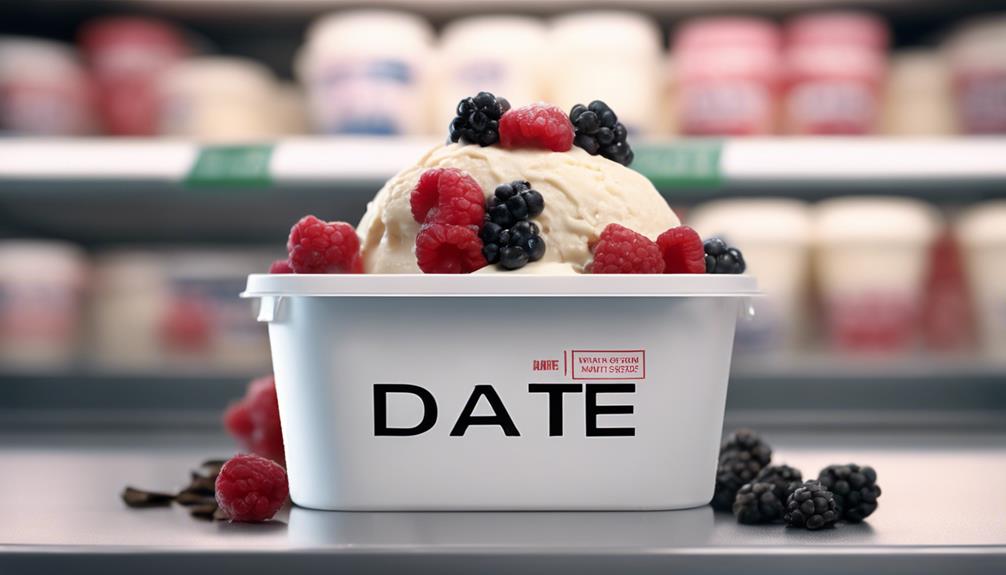
Store any remaining Ninja Creami vanilla ice cream in an airtight container in the freezer to maintain its creamy texture and prevent freezer burn. Proper storage is essential to preserving the delicious flavor of the ice cream. To guarantee the best quality, enjoy the ice cream within a week of freezing.
When storing in a Ninja Creami pint container, make certain it's sealed tightly to prevent any air from entering, which can cause the ice cream to develop ice crystals and lose its smooth consistency.
Following appropriate freezing guidelines will help retain the ice cream's creamy texture. Before serving, allow the ice cream to soften slightly by placing it in the refrigerator for a few minutes. This will make scooping easier and ensure a delightful experience with every spoonful.
Sharing Feedback and Love

Feel free to engage with the Ninja Creami Vanilla Ice Cream recipe by sharing your feedback and spreading the love for this delightful treat. When you try this creamy ice cream, don't hesitate to leave your thoughts on the flavor, texture, and overall experience.
Positive feedback often highlights the simplicity of making this delicious dessert and the satisfaction of enjoying a homemade treat.
Interacting with the recipe author and fellow readers through comments creates a sense of community and shared love for ice cream. Your feedback isn't only appreciated but also valuable.
Share any modifications or customizations you've made to the recipe to make it your own. Your input can inspire others to try new variations and enhance their ice cream-making adventures.
Join the conversation, offer suggestions, and celebrate the joy of creating Ninja Creami Vanilla Ice Cream together. Together, we can make this recipe even more delightful for everyone in our growing community of ice cream enthusiasts.
Handy Tips for Perfecting Texture

To enhance the creaminess and smoothness of your Ninja Creami Vanilla Ice Cream, focus on these handy tips for perfecting its texture:
Properly Freeze the Base: Make sure the ice cream base is frozen for 24 hours before churning to achieve a smoother texture.
Adjust Churning Time: Modify the churning time to your liking for a firmer or softer consistency, tailoring it to your preference.
Re-Spin if Necessary: If the ice cream appears crumbly or uneven, re-spin it to improve overall smoothness and texture.
Experiment with Mix-Ins: Try different mix-ins and flavors to add texture and depth to your ice cream, enhancing the overall taste experience.
Non-Ninja Creami Ice Cream Options
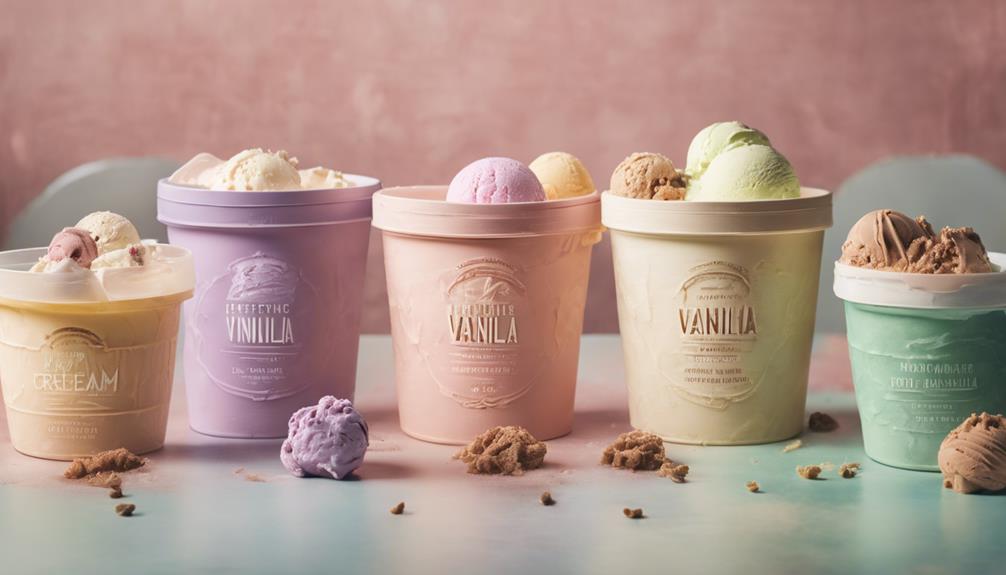
It should be highlighted that exploring alternative ice cream makers is recommended if you don't own a Ninja Creami for creating creamy vanilla ice cream at home. Traditional ice cream makers often require more manual effort and time compared to the automated process of the Ninja Creami. Non-Ninja Creami options may lack specific functions like automated churning cycles, making it necessary for you to monitor and adjust the churning process manually for consistent results.
Homemade ice cream without a Ninja Creami might involve more hands-on involvement during the churning process. Non-Ninja Creami options may not offer the same level of convenience and ease of use when making creamy vanilla ice cream. These alternative ice cream makers could have varying freezing and churning mechanisms, leading to different textures and outcomes compared to what you might achieve with a Ninja Creami.
Frequently Asked Questions
Why Is My Ninja Creami Not Creamy?
If your Ninja Creami isn't creamy, check ingredient temperatures, ratios, and churning duration. Make adjustments during churning for a creamier outcome. Store the ice cream properly post-churn. These steps guarantee a perfect texture every time.
Why Is My Ice Cream Crumbly From the Ninja Creami?
When your ice cream turns crumbly from the Ninja Creami, it's likely because the mixture didn't freeze long enough before churning. Give it a solid 24 hours in the freezer next time for that creamy texture you crave!
Why Is My Ninja Creami Ice Cream Too Fatty?
If your Ninja Creami ice cream ends up too fatty, try softening cream cheese, adjusting ingredients, or using low-fat milk. Incorporate protein drinks or fresh ingredients for balance. Experiment with recipes for the perfect texture.
Why Does My Ninja Creami Ice Cream Taste Waxy?
If your Ninja Creami ice cream tastes waxy, it might be due to over-churning or excessive fat content. To fix this, try reducing fat or churning time. Soften cream cheese before mixing to avoid the waxy aftertaste.
Can I Use the Ninja Creami to Make Pistachio Ice Cream as Well?
Yes, the Ninja Creami is perfect for creating a delicious nutty pistachio ice cream recipe. Its powerful blending capabilities and innovative design will help you achieve the perfect creamy texture and rich pistachio flavor in no time. Enjoy homemade pistachio ice cream with the Ninja Creami today.
Conclusion
So there you have it – with the right ingredients, techniques, and a little Ninja Creami magic, you can create the perfect vanilla ice cream every time!
Did you know that vanilla ice cream is the most popular flavor in the United States, accounting for over 30% of all ice cream sales?
So next time you whip up a batch, remember you're not alone in your love for this classic treat!





